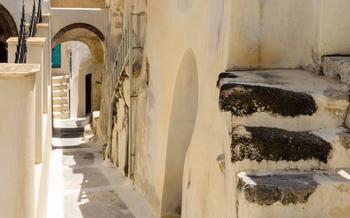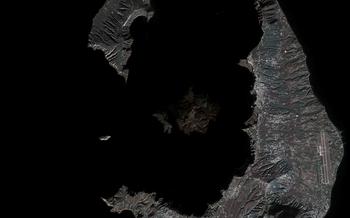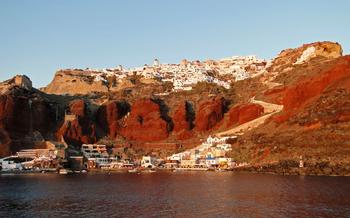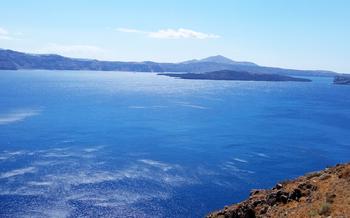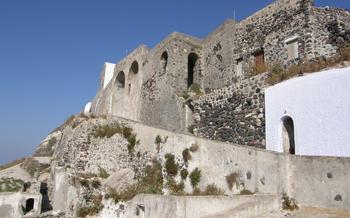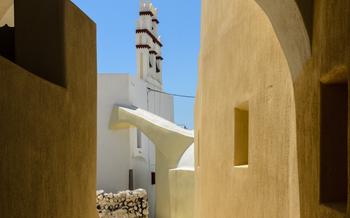
Cultural Village
- Oia Village
- Maritime Museum
- Archaeological Museum of Thera
- Megalochori Village: A Timeless Enchantment
- Akrotiri Excavation Site
- Wine Museum
- Pyrgos Village: A Timeless Enchantment
- Red Beach
- Ancient Thera
- Nea Kameni Volcano
- Firostefani Village: A Caldera-Rim Gem
- Perissa Black Beach
- Insider Tip:
Oia Village
Oia, perched on the northern tip of Santorini, is a picturesque village renowned for its stunning views of the caldera and the Aegean Sea. With its traditional whitewashed houses and blue-domed churches, Oia exudes a charm that has captivated visitors for generations. Wander through the village's narrow streets and marvel at the beautiful architecture, where each house seems to be perfectly positioned to offer breathtaking vistas of the caldera.
Oia's history is as rich as its scenery. Once a small fishing village, Oia transformed into a thriving maritime center during the 19th century. The village's seafaring heritage is still evident in the many captains' houses and churches dedicated to patron saints of sailors. Today, Oia is a popular destination for art lovers, with numerous galleries showcasing the works of local and international artists.
One of the highlights of Oia is its stunning sunset views. As the sun dips below the horizon, the sky transforms into a canvas of vibrant colors, casting a magical glow over the village and the caldera. Find a spot at one of the many viewpoints, such as the Oia Castle or the Sunset Taverna, and witness this natural spectacle that has become synonymous with Santorini.
Maritime Museum
The Maritime Museum, situated in the picturesque village of Oia, narrates the compelling maritime narrative of Santorini. Through meticulously preserved artifacts, model ships, and navigational tools, the museum elucidates the island's pivotal role in Mediterranean maritime trade routes and its rich seafaring heritage. A significant highlight of the museum is its impressive collection of beautifully crafted model ships, ranging from ancient vessels to modern-day marvels, which offer visitors a glimpse into the evolution of shipbuilding techniques.
The Maritime Museum's exhibits provide an intriguing insight into the lives of Santorini's seafarers, showcasing their navigational skills, trading practices, and the challenges they faced while traversing the vast expanse of the Mediterranean Sea. A particular exhibit that captures the imagination is a replica of a traditional caique, a type of wooden sailing vessel commonly used by Greek fishermen. This life-size model allows visitors to step back in time and experience the maritime traditions of Santorini firsthand.
The museum's knowledgeable guides are passionate about sharing their expertise and narrating stories of Santorini's seafaring past. Guided tours are available in multiple languages, providing visitors with a comprehensive understanding of the island's maritime history and its enduring significance to the local culture and economy.
Archaeological Museum of Thera
The Archaeological Museum of Thera is a treasure trove of artifacts from the ancient city of Thera, which was destroyed by a volcanic eruption in the 16th century BC. The museum houses a fascinating collection of frescoes, pottery, sculptures, and tools that provide a glimpse into the life and culture of the Minoan civilization.
Among the highlights of the museum are the stunning frescoes from the Akrotiri excavation site. These vibrant and well-preserved paintings depict scenes from daily life, religious rituals, and the natural world. The museum also displays a collection of pottery, including intricate vases, jugs, and cups, as well as sculptures, tools, and other artifacts that shed light on the advanced civilization that once thrived on Santorini.
A visit to the Archaeological Museum of Thera is a must for anyone interested in history and archaeology. The museum's exhibits provide a fascinating insight into the life and culture of the Minoan civilization and the devastating volcanic eruption that destroyed their city. Guided tours are available to help visitors understand the significance of the artifacts and learn more about the history of Thera.
Megalochori Village: A Timeless Enchantment
Nestled in the heart of Santorini, Megalochori Village captivates visitors with its authentic charm and timeless beauty. Stroll along the narrow, winding streets adorned with traditional whitewashed houses and discover hidden gems around every corner. Admire the grandeur of the Venetian castle, a testament to the island's rich history, and explore the intricate Byzantine churches that speak of deep-rooted spiritual traditions.
Immerse yourself in the vibrant art scene as you browse through the village's many art galleries, showcasing the talents of local and international artists. Discover unique boutiques filled with handmade crafts and souvenirs, perfect for taking a piece of Megalochori's essence back home.
Relax in one of the traditional tavernas, savor delicious local cuisine, and engage with the friendly locals who warmly welcome visitors into their community. Experience the relaxed atmosphere and embrace the slow pace of life as you soak in the tranquility of this picturesque village.
Akrotiri Excavation Site
The Akrotiri Excavation Site is a must-see for anyone interested in ancient history and archaeology. Located on the southern coast of Santorini, this Minoan settlement was buried by a volcanic eruption around 1600 BC and remained remarkably well-preserved under a thick layer of ash and pumice.
Excavations began in the 1960s and have revealed an extensive network of streets, houses, and workshops, providing a fascinating glimpse into the daily life of the Minoan people. The site is particularly notable for its well-preserved frescoes, which depict scenes from everyday life, religious rituals, and the natural world.
Among the most famous frescoes are the "Spring Fresco," which depicts a lush landscape with flowers and birds, and the "Flotilla Fresco," which shows a group of ships sailing across the sea. These vibrant and detailed paintings offer a unique insight into the artistic and cultural achievements of the Minoan civilization.
Guided tours are available to explore the Akrotiri Excavation Site, and visitors can learn about the history of the Minoan civilization, the volcanic eruption that destroyed the settlement, and the ongoing archaeological research at the site.
Wine Museum
The Wine Museum, situated in the picturesque village of Mesa Gonia, offers a captivating journey into the history and traditions of winemaking in Santorini. The museum showcases a rich collection of exhibits that vividly illustrate the unique viticulture of the island. Explore the fascinating displays of traditional winemaking equipment, ancient amphorae, and contemporary winemaking techniques. Learn about the distinctive volcanic soil and the indigenous grape varieties that thrive in Santorini's unique terroir. Engage your senses with a guided tour that includes a tasting of local wines, allowing you to savor the exceptional flavors and aromas that make Santorini's wines so renowned.
Pyrgos Village: A Timeless Enchantment
Perched majestically atop a hill, the village of Pyrgos stands as a testament to Santorini's rich history and architectural heritage. Its narrow, labyrinthine streets, adorned with whitewashed houses and colorful bougainvillea, transport visitors back in time. The village's crown jewel is the Venetian castle, a symbol of Santorini's bygone era of Venetian rule. Its imposing walls and well-preserved towers offer breathtaking panoramic views of the island, stretching from the deep blue Aegean Sea to the volcanic caldera.
Pyrgos is also home to a cluster of Byzantine churches, each with its own unique charm and historical significance. The Church of Agios Nikolaos, with its intricately carved bell tower, is a must-see for architecture enthusiasts. The Church of Panagia Episkopi, nestled amidst a tranquil cypress grove, exudes an aura of serenity and spirituality.
Beyond its historical treasures, Pyrgos offers a vibrant cultural scene. Art galleries and boutiques line the village's main street, showcasing the works of local artisans and craftspeople. Visitors can find everything from traditional pottery and jewelry to contemporary paintings and sculptures.
As the sun begins to set, Pyrgos transforms into a magical realm. The village's whitewashed buildings glow in the golden light, casting long shadows across the cobblestone streets. The atmosphere becomes electric as locals and tourists alike gather in the village's tavernas, enjoying delicious Greek cuisine and lively conversation.
Whether you're a history buff, an art lover, or simply seeking a taste of authentic Santorini, Pyrgos Village offers an unforgettable experience. Its timeless charm, breathtaking views, and vibrant atmosphere make it a must-visit destination for any traveler seeking the essence of this enchanting island.
Red Beach
The Red Beach is one of the most unique and striking beaches in Santorini, formed by volcanic activity that has given the sand a vibrant red hue. The dramatic cliffs that surround the beach, coupled with the crystal-clear waters, create a breathtaking landscape that is sure to leave you in awe.
Swimming and sunbathing are popular activities at the Red Beach, but snorkeling is also a great way to explore the underwater world and discover the diverse marine life that inhabits these waters. The beach can be reached by boat from the port of Akrotiri or by hiking along a scenic trail that offers stunning views of the caldera.
Whether you choose to relax on the beach, take a dip in the sea, or embark on a snorkeling adventure, the Red Beach promises an unforgettable experience. Just remember to bring your camera to capture the vibrant colors and the stunning scenery that make this beach so special.
Ancient Thera
Ancient Thera, also known as Thira or Thera, is an archaeological site of the ancient city of Thera located on Mesa Vouno, a hilltop overlooking the modern city of Fira. The site dates back to the 9th century BC and was inhabited until the 7th century AD. Ancient Thera was a significant city in the ancient world and was part of the Dorian Hexapolis, a league of six Dorian cities.
The city was divided into an upper and lower city, with the upper city being the acropolis, where the temples and other important buildings were located. The lower city was where the residential areas and shops were located. The city was surrounded by a wall, which was built in the 4th century BC.
Ancient Thera is a popular tourist destination and visitors can explore the remains of the city, including the temples, theaters, and public buildings. Highlights of the site include the Temple of Apollo, the Agora, the Theater, and the Odeon. The site also offers stunning views of the caldera and the Aegean Sea. Guided tours are available for visitors who want to learn more about the history and archaeology of the site.
Nea Kameni Volcano
Nea Kameni, meaning "New Burnt", is still considered an active volcano.
The island is barren and uninhabited, with a stark and dramatic landscape. The Nea Kameni volcano is a popular tourist destination, and visitors can hike to the crater, where they can see the still-smoking vents and feel the heat of the earth beneath their feet.
The volcano is also home to a number of hot springs, which are said to have therapeutic properties. Visitors can relax in the warm waters and enjoy the stunning views of the caldera.
Boat tours to Nea Kameni are available from Santorini, and the trip takes about 30 minutes. Visitors can also swim in the clear waters of the caldera and explore the surrounding lava fields.
Nea Kameni is a fascinating and unique destination, and a must-visit for anyone interested in volcanology or geology.
Firostefani Village: A Caldera-Rim Gem
Nestled atop the caldera rim, Firostefani Village enchants visitors with its breathtaking views of the Aegean Sea and the iconic Santorini caldera. Stroll along the village's narrow, winding streets and admire the traditional whitewashed houses with their blue-domed churches, creating a picturesque scene that will leave you breathless. Indulge in the relaxed atmosphere and savor delicious local cuisine at one of the many tavernas, while enjoying the stunning vistas that surround you. As the sun begins to set, find a spot to witness the magical sunset, where the sky transforms into a canvas of vibrant colors, casting a golden glow upon the entire village. Firostefani offers a perfect blend of tranquility and awe-inspiring beauty, making it a must-visit destination for anyone seeking an authentic Santorini experience.
Perissa Black Beach
On the southeastern coast of Santorini, you'll find Perissa Black Beach, a unique and captivating destination known for its striking black sands, crystal-clear waters, and dramatic cliffs. This beach is formed from volcanic ash and minerals, giving it its distinctive dark color. The black sand absorbs and retains heat, making it a warm and inviting spot to relax and soak up the sun.
Perissa Black Beach is a popular spot for swimming, sunbathing, and water sports. The waters here are calm and clear, making it ideal for swimming and snorkeling. You can also rent kayaks, paddleboards, and jet skis to explore the coastline and take in the stunning views.
The beach is surrounded by towering cliffs, adding to its dramatic and picturesque scenery. These cliffs provide shelter from the wind, creating a more relaxed and sheltered environment for beachgoers. Whether you're looking to swim, sunbathe, or simply take in the beauty of the surroundings, Perissa Black Beach is a must-visit destination in Santorini.
To reach Perissa Black Beach, you can take a bus or rent a car. The beach is well-connected to other parts of the island, making it easy to incorporate into your Santorini itinerary. Remember to bring your sunscreen, sunglasses, and a hat to protect yourself from the intense Greek sun.
Insider Tip:
To truly immerse yourself in the charm of Santorini without the overwhelming crowds, consider visiting during the shoulder seasons - May to June and September to October. During these months, the weather is still pleasant, with warm days and cool evenings, but the influx of tourists is significantly reduced. This allows you to explore the island's attractions, such as the cultural villages and archaeological sites, at a more leisurely pace, without having to navigate through throngs of people. Additionally, the prices for accommodations and services tend to be lower during these periods, making it a more budget-friendly time to visit. Whether you seek tranquility, affordability, or a more authentic experience of Santorini's culture, the shoulder seasons offer an ideal opportunity to discover the island's hidden gems and create lasting memories.

